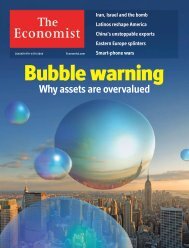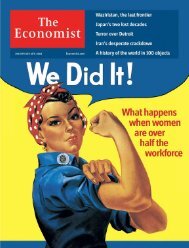[ccebook.cn]The World in 2010
[ccebook.cn]The World in 2010
[ccebook.cn]The World in 2010
You also want an ePaper? Increase the reach of your titles
YUMPU automatically turns print PDFs into web optimized ePapers that Google loves.
Bus<strong>in</strong>ess<br />
Asia's green-tech rivals<br />
Nov 13th 2009<br />
Clean-energy competition <strong>in</strong> the region will be <strong>in</strong>tense<br />
<strong>The</strong> battle l<strong>in</strong>es are be<strong>in</strong>g drawn <strong>in</strong> Asia over green technologies, as governments adapt their tradition of state<br />
<strong>in</strong>fluence on <strong>in</strong>dustry for an era <strong>in</strong> which eco-friendly products may spell export success. In Ch<strong>in</strong>a, Japan,<br />
South Korea and elsewhere, a big portion of fiscal-stimulus measures is dedicated to green projects. It is seen<br />
as a way to create new jobs, cut carbon emissions at home—and sell products abroad.<br />
Globally, governments have budgeted as much as $500 billion for “Green New Deal” projects, estimates<br />
HSBC, a bank. Asia accounts for more than three-fifths of the total. Around 20% of this will have been spent<br />
by the end of 2009, with most of the rest to be lavished <strong>in</strong> <strong>2010</strong>. Private capital is also pour<strong>in</strong>g <strong>in</strong>.<br />
Yet where the money is go<strong>in</strong>g varies across the region. Some countries are emphasis<strong>in</strong>g particular sectors<br />
(like solar power) or early-stage technology (such as fuel cells) with an eye towards build<strong>in</strong>g a future market.<br />
Other <strong>in</strong>itiatives simply apply current technology to reduce domestic emissions (carbon-capture at power<br />
plants, for example). Only 15% of the spend<strong>in</strong>g is aimed at R&D, notes New Energy F<strong>in</strong>ance, a marketresearch<br />
group.<br />
Ch<strong>in</strong>a, by some measures, has the most ambitious policy. It has dedicated around $220 billion, or one-third of<br />
its overall fiscal stimulus, to projects such as w<strong>in</strong>d, solar, hydropower and clean-coal technologies. This will<br />
help the country achieve its target of <strong>in</strong>creas<strong>in</strong>g the share of renewable energy to 10% by <strong>2010</strong>.<br />
In <strong>2010</strong> a generous subsidy will become available for low-emission cars <strong>in</strong> 13 big cities, <strong>in</strong>clud<strong>in</strong>g Beij<strong>in</strong>g,<br />
Shanghai and Dalian. Ch<strong>in</strong>a will also subsidise 50-70% of the cost of large solar-power projects.<br />
<strong>The</strong> emphasis on solar energy is as much a lifel<strong>in</strong>e for flounder<strong>in</strong>g Ch<strong>in</strong>ese firms as it is an effort to reduce<br />
emissions. Without subsidies, solar is about four times more expensive than energy from the coal-powered<br />
grid. But Ch<strong>in</strong>ese firms have emerged as the biggest solar-panel producers <strong>in</strong> the world—almost all of it<br />
exported—just as the <strong>in</strong>dustry faces a massive supply glut that is forc<strong>in</strong>g firms to close. By boost<strong>in</strong>g domestic<br />
demand, Ch<strong>in</strong>a’s programme has the added goal of absorb<strong>in</strong>g the excess supply, and help<strong>in</strong>g the firms to live.<br />
-155-<br />
Corbis


![[ccebook.cn]The World in 2010](https://img.yumpu.com/12057568/158/500x640/ccebookcnthe-world-in-2010.jpg)





![[ccebbook.cn]The Economist August 1st 2009 - the ultimate blog](https://img.yumpu.com/28183607/1/190x252/ccebbookcnthe-economist-august-1st-2009-the-ultimate-blog.jpg?quality=85)




![[ccemagz.com]The Economist October 24th 2009 - the ultimate blog](https://img.yumpu.com/5191885/1/190x252/ccemagzcomthe-economist-october-24th-2009-the-ultimate-blog.jpg?quality=85)